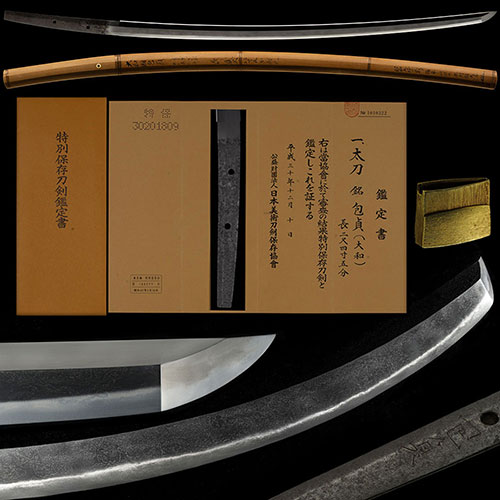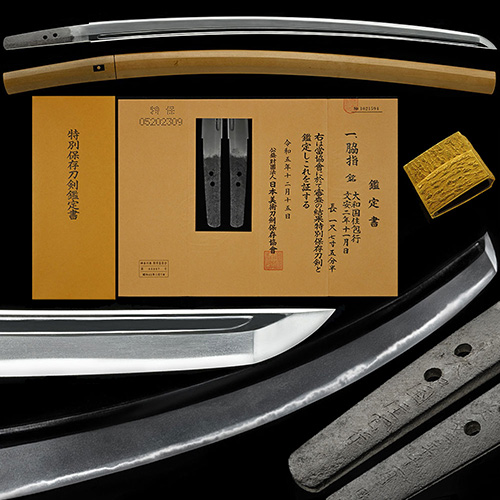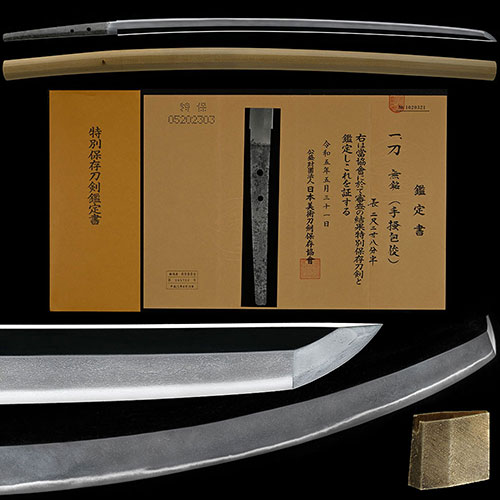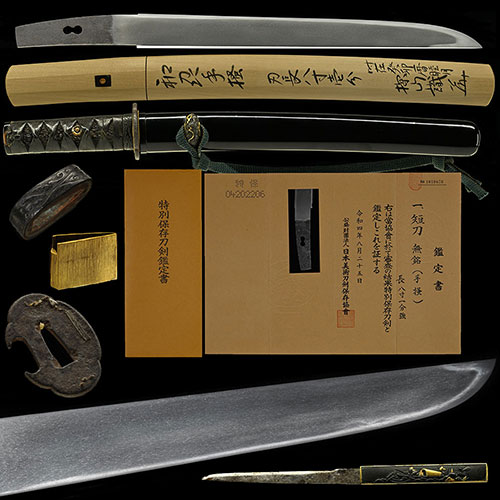
包貞 太刀Kanesada Tachi
No.054086在銘太刀 包貞 手掻包永子 南北朝貞和頃 金筋掛り匂口明るく冴える健全傑作刀 二尺四寸五分Zaimei Tachi Kanesada Tegai Kanenaga' child, Nanbokucho period around Joule, Kinsuji-kakari, Nioikuchi is bright and clear, A masterpiece Kenzen 74.2cm
ご成約Sold
関連商品
- 銘表Mei-Omote
- 包貞包貞 Kanesada
- 登録証Registration
- 東京都 Tokyo 昭和49年5月16日 5/16/49(Showa)
- 時代Period
- 南北朝時代Nanbokucho period
- 法量Size
-
刃長 74.2cm (二尺四寸五分) 反り 1.8cm
元幅 3.0cm 先幅 2.0cm 元重 0.56cm 鎬厚 0.69cm 先重 0.42cm 鋒長 3.3cm 茎長 22.7cm 重量 801gHachou 74.2cm (二尺四寸五分) Sori 1.8cm
Moto-Haba 3.0cm Saki-Haba 2.0cm Moto-Kasane 0.56cm Shinogi-Thikess 0.69cm Saki-Kasane 0.42cm Kissaki-Chou 3.3cm Nakago-Chou 22.7cm Weight 801g - 国Country
- 大和Yamato
- 姿Shape
- 鎬造、庵棟、身幅広く、反りやや深く、腰反りつき、中鋒。Shinogidukuri, Iorimune, Wide Mihaba, Slightly deep Sori, Koshizori-tsuki, Chu-Kissaki.
- 鍛Kitae
- 板目肌に、杢目・流れ肌交じり、地沸微塵に厚くつき、地景よく入り、映りたつ。Itame-hada, Mokume, Mixed Nagare-hada, Jinie entered fine and thick, Chikei entered well, Utsuritatsu.
- 刃文Hamon
- 中直刃に、ほつれ・食い違い・二十刃かかり、小足・葉入り、小沸よくつき、金筋・沸筋かかり、匂口明るく冴える。Chu-Suguha, Hotsure, Kuichigai, Nijuba-kakari, Small-Ashi and You enter, Small-Nie enter well, Kinsuji and Niesuji-kakari, Nioikuchi is bright and clear.
- 帽子Boushi
- のたれて焼き詰める。Notarete-Yakitsumeru.
- 茎Nakago
- 磨上、先切、鑢目筋違、目釘孔二。Suriage, Sakikiri, Yasurimesujikai, Mekugiana are two(2)
- ハバキHabaki
- 金着二重。Double gold layre.
- 説明Drscription
- 大和手掻派は、鎌倉後期正応(1288年)頃の包永を祖とし、尻懸派と同じく東大寺に隷属していた刀工群で、南北朝時代にかけて大いに繁栄した。包貞は、初代包永の子とも二代包永の子とも伝え、鎌倉末期文保頃或いは南北朝時代貞和頃に活躍した。
この刀は、包貞二字銘が鏨枕が残るほど健全な希少なもので、反りやや深く、中鋒となる鎌倉末期の姿で、杢目肌が良く交じる板目肌に、地沸微塵に厚くつき、映りたち、地景美しく入る地鉄に、中直刃に、ほつれ・食い違い・二十刃かかり、小足・葉入り、小沸よくつき、金筋・沸筋かかるなど刃中の働き豊かで、匂口明るく冴える。地刃ともに頗る健全で、出来が優れる重要候補の傑作である。The Yamato Tegai school was a group of swordsmiths that originated from Kanenaga around the late Kamakura period (1288), and like the Shikkake school, they were subordinate to Todaiji Temple, and flourished during the Nanbokucho period.
It is said that Kanesada was the son of the first Kanenaga and the second Kanenaga, and was active around the Bunpo period of the late Kamakura period or around the Jouwa period of the Nanbokucho period.
This sword is Kenzen so rare that the two-character Kanesada inscription remains, Slightly Shallow Sori, Chu-Kissaki is the appearance of the late Kamakura period, with Mokume-hada, Mixed Itamehada well, Jinie entered fine and thick, Utsuritachi, Chikei in beautiful Jitetsu, Chu-Suguha, Hotsure, Kuichigai, Nijuba-kakari, Small-Ashi and You enter, Small-Nie entered well, Kinsuji, Niesuji-kakaru, It works well in sword, Nioikuchi is bright and clear.Both Jiba and Kenzen are excellent, and it is a masterpiece of an important candidate with excellent sword.





